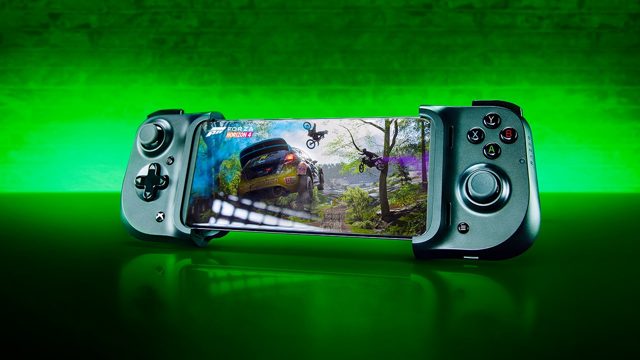Razer Kishi for Android (Xbox)
The Xbox version of the Razer Kishi for Android is an easy way to add physical controls to your phone for playing games over Project xCloud.

With Google Stadia and PlayStation Now already out, and Project xCloud coming out of beta later this year, playing console games on your phone is a reasonable endeavor (if you have a strong enough network connection to keep the stream going). You still need a good control scheme to play games, since they aren’t designed for touch screens. The Razer Kishi is one such solution. This $99.99 device is a physical controller that snaps around your phone like Joy-Cons on a Nintendo Switch, and provides the same buttons and sticks as a conventional dual analog gamepad.
The Xbox version of the Razer Kishi is designed specifically for use with Project xCloud, but there aren’t any significant physical differences between it and the non-Xbox Kishi except the branding, and the availability of an iOS model for the non-Xbox controller. The Xbox version meets Designed for Xbox Game Pass requirements through compatibility testing with the Xbox team, so it’s guaranteed to work with Project xCloud. This version of the controller also comes with a 14-day trial subscription to Xbox Game Pass Ultimate, though whether those distinctions are worth the extra $20 on the price compared with the non-Xbox version Kishi remain to be seen.
Razer Kishi Design

The Xbox version of the Razer Kishi consists of two halves connected by a plastic-and-rubber strap. Each half is a chunky, curved black plastic shell with an analog stick and two triggers. Additional controls include a directional pad and Guide and View buttons for the left half, four face buttons and a Menu button on the right half. Each half also features a wide recess on the same side as the strap connects that’s designed to hold the top or bottom edge of a compatible phone. A USB-C plug sits in the recess of the right half of the controller. The right half also holds a USB-C port on its bottom edge. Kishi doesn’t have a battery of its own, so it draws power from the connected phone. The USB-C port provides passthrough charging for your phone while you’re using the controller.
The control layout is similar to the Xbox Wireless Controller, with the Guide, Menu, and View buttons. The non-Xbox version of the Kishi has the same layout, though the function buttons are marked with Start/Forward, Back, and Home icons instead of the Xbox controller icons. The Xbox Kishi is only compatible with Android phones, but the non-Xbox model is also available in a variant with a Lightning plug instead of USB-C, for use with iPhones.
For storage, when the Kishi isn’t attached to your phone—the two halves of the controller snap together. The band folds neatly under a backplate that locks the two halves securely. The backplate is released by pulling on two tabs on the back of the controller, letting you pull the halves apart to play. It’s a compact package when folded up, measuring approximately 3.5 by 5.4 inches by 1.2 inches thick (HWD), including the analog sticks.
To use the Kishi, slide a compatible phone into the right half of the controller, connecting it via the USB-C plug inside the recess on the left side. The Kishi can accept a Samsung Galaxy S8 or Note 8 or newer, Google Pixel 2 or 2XL or newer, or the Razer Phone or Razer Phone 2. It should work with other USB-C-equipped phones within the supported dimensions (5.72 to 6.44 inches long, 2.68 to 3.07 inches wide, and 0.28 to 0.34 inches thick). The Kishi proved to be a perfect fit for my Google Pixel 3a XL.
Performance

Since it works through a USB-C connection, the controller begins functioning with the phone as soon as you insert the phone into it. I immediately accessed the Project xCloud app, and navigated it using the Kishi’s analog stick or direction pad. I also fired up several games through the app, and used the controller as if I were playing on an Xbox One with a standard Xbox gamepad in my hands.
The controls feel good with most Project xCloud games. Fighting game Soul Calibur VI plays responsively through the service using the Kishi controller (when I had a very good Wi-Fi connection, of course). The interface elements in some games, like the create-a-character menus in Soul Calibur VI, can be uncomfortable to read on a phone screen. This is the natural result of playing a console game on a display much smaller than it was designed for, a fundamental issue of Project xCloud and other game streaming services.
The Razer Kishi works perfectly with Project xCloud, but whether it will work with other games depends entirely on each game’s controller support and how it’s implemented. For example, I couldn’t get the Kishi to work with Call of Duty: Mobile. Though that game supports controllers, it only works with them over Bluetooth connections, not wired connections. However, the Kishi worked just fine with Asphalt 9 Legends, with all controls functioning perfectly between menu navigation and steering.
Small Body, Big Price
The Razer Kishi is a good-feeling, compact little controller that lets you play Project xCloud games with proper physical controls. It’s expensive, though, and outside of Project xCloud you still have to deal with the frustrating inconsistencies of Android controller support. We much prefer the PowerA Moga XP5-X Plus, a full-size gamepad with a phone clip that provides all of the same controls as the Razer Kishi for $30 less, and with two additional programmable buttons and a built-in battery pack for charging your phone on top of that.




